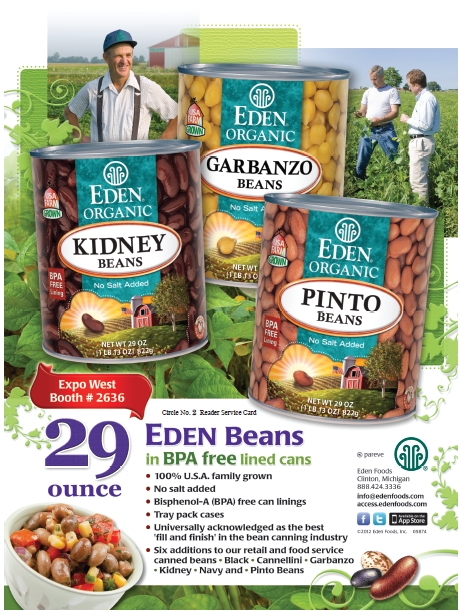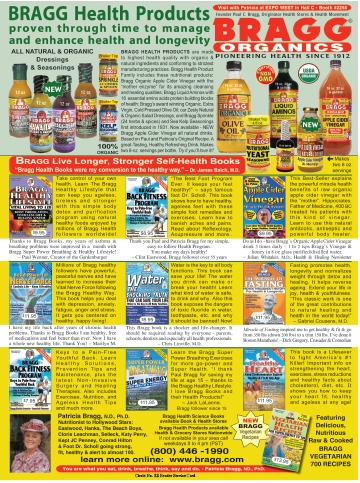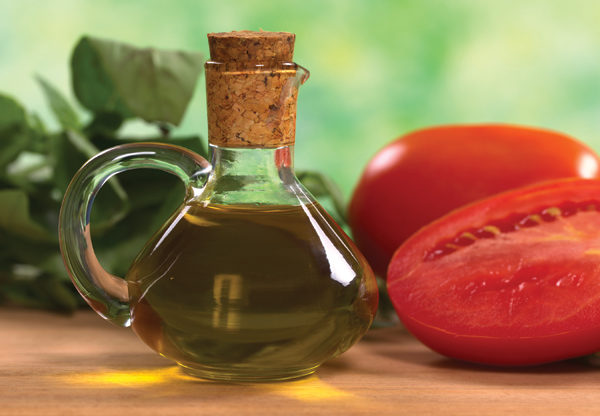Today, everyone is a chef, as consumers go to grocery stores in droves looking for cooking oils to add to their home concoctions, be they salads or sizzling sauté dishes. You should be ready to guide them toward oils that not only taste good and are versatile in the kitchen, but also represent a step in the right direction for a healthy diet.
Getting Creative in the Kitchen
In her cooking classes centered on the use of olive oil, Mary Platis likes to tell her students, first and foremost, to become familiar with the taste of this ingredient. A Greek chef, she is a consultant on an organic extra-virgin olive oil product sourced from Greece and offered by Bragg Live Food Products, Santa Barbara, CA. Platis explains that a cooking oil has to fit the food you’re cooking it with, and that olive oil happens to be a perfect match for all of the food found in the pop ular Mediterranean diet.
ular Mediterranean diet.
She also instructs people on how to look at olive oil labels when they’re at the store. She says to look for unrefined, pure olive oil as detailed on the label to find the best products. USDA and IOOC (International Olive Oil Council) certified organic olive oil from Greece is one example of quality that she cites, while others may be familiar with the famous “Made In Italy” designation of other extra-virgin oils. Including sharing her Greek food heritage on her blog at www.californiagreekgirl.com, Platis is an all-around advocate for olive oil in the home kitchen because of its wide array of applications as well as its stellar health profile.
In her classes, she takes students through the process of sautéing with olive oil (don’t use high heat, because it can strip olive oil of its health benefits), roasting with it and using it as an ingredient in sauces and marinades. At the end of a given recipe, she’ll use the oil to further enhance the dish: drizzling olive oil on a soup, over a finished pizza or over an ice cream dish that is already infused with olive oil to enhance the flavor.
Importantly, Platis encourages home cooks to utilize olive oil in place of butter when they can. Keeping in mind that olive oil, like all oils, is characterized by its fat content (one tablespoon, Platis says, equates to about 120 calories), the practice of using it as a butter replacement can improve the health profile of meals without sacrificing taste. “It has this robust flavor, peppery…it gives you that zing at the end in your throat,” Platis says.
Extra-virgin olive oil is also good for drizzling on pasta and vegetables, she says. “When you marinate with olive oil, it penetrates the first few layers of the food. So, it does give it that buttery, peppery feeling that you want for your meats or chicken,” she adds. In general, adding it as a finishing touch enhances the flavors inherent in the food, especially of the Mediterranean variety. Platis goes on to cite further applications: using it as an ingredient in hummus, in various desserts, in Greek and herbal salad dressings, as a bread dip and in making savory breads. All are useful ideas, and excitingly, they do not exhaust the culinary potential of olive oil as an ingredient.
 Mary Ann Siciliano, national sales manager of Arista Industries, Inc., Wilton, CT, reels off many of the other home cooking oils and their typical uses as she sees them. “Some of the specialty oils, like avocado, brazil nut, grape seed, hazelnut, macadamia and rice bran are used on salads, whereas the less expensive oils, like canola, corn, olive, safflower, sunflower and soy are used for baking and frying.”
Mary Ann Siciliano, national sales manager of Arista Industries, Inc., Wilton, CT, reels off many of the other home cooking oils and their typical uses as she sees them. “Some of the specialty oils, like avocado, brazil nut, grape seed, hazelnut, macadamia and rice bran are used on salads, whereas the less expensive oils, like canola, corn, olive, safflower, sunflower and soy are used for baking and frying.”
Coconut oil, also, should not go unmentioned, as it surges in popularity as a cooking ingredient in the United States. “The high smoke point of coconut oil makes it ideal for browning meats and sautéing vegetables. Coconut oil also makes a light, flaky pie crust, and is a great vegan butter alternative in all baked goods,” says Erin Meagher, founder of Kelapo Coconut Oil, Tampa, FL. Though it has not enjoyed the reputation for long, many consumers look at it today as more than a tropical novelty. “We always say that organic coconut oil is perfect for all dishes from savory to sweet. The flavor of coconut oil is extremely versatile,” Meagher says. Its reputation from a health perspective, as we’ll see, is in the process of rehabilitation, too.
Austrian pumpkin oil has an extensive history of consumption for its health benefits. Derived from the roasted seeds of the Styrian pumpkin variety (curcubita pepo var. styriaca), it can be used in desserts or on salads. Cooking with it, however, will strip it of some of the nutrients that lend it a strong reputation for healthfulness.
Not all desire it in every culinary context, but for those that would like their cooking oil to become an integral part of the flavor of a dish, the key is to keep things unrefined, according to Hillary Kallaway, training manager for Spectrum Organic Products, Petaluma, CA. Consumers should select an unrefined olive, coconut, sesame or peanut oil, she argues, in order to bring taste to the forefront. “Unrefined oils retain their natural flavors and are best used at lower heats. They can also be drizzled over the finished dish for added flavor,” she says.
As awareness of the healthy oil offerings available to U.S. consumers grows, there is an opportunity for an already robust market to flourish. Says TJ McIntyre, vice president and general manager of Earth Balance, Longmont, CO, “If healthy oils are able to replace butter and still deliver on taste and performance in cooking and baking, there is not only an opportunity to highlight a very relevant difference from a saturated fat perspective, but there are allergy avoidance (lactose allergy and intolerance, casein allergy and avoidance) and ethical driven avoidance (vegans) issues that are a bona fide market opportunity for retailers.”
Better For You
In some cases, it’s a matter of selecting an oil that is natural over others that are synthetic and unhealthy. Or, we may focus on inherent differences in the healthfulness of an oil’s nutritive content. But any comparison of the health benefits of one oil with those of another usually begins with their respective fat profiles. “The problem with the American diet is it’s very high in saturated fat. Of course, we know that a diet high in saturated fat promotes increased cholesterol and increases risk of heart disease,” says John Westerdahl, Ph.D., R.D., director of health science for Bragg Live Food Products, and host of the national radio program Health & Longevity (www.HealthAndLongevityRadio.com). These saturated fats are ingested primarily in the form of animal products, dairy and hydrogenated fat in processed food.
Organic extra-virgin olive oil, Westerdahl says, is optimal for replacing these other types of fats, mostly due to its monounsaturated fat content. People following the Mediterranean diet often eat similar amounts of total fat as other cultures that suffer more from obesity and disease. But, he points out, the type of fat consumed differs greatly. Westerdahl adds that polyunsaturated fats may also need to be avoided in large quantities. They have been linked to the production of carcinogenic compounds and an increased risk of cancer, he says, neither of which is the case with the monounsaturated fat that predominates pure olive oil. Informally, he breaks down olive oil’s fat content this way: a typical tablespoon will contain about 14 grams of fat. Two grams of that fat is saturated, none is trans fat, two grams are polyunsaturated and 10 grams are monounsaturated.
One of the things that makes the koroneiki olive variety native to Greece unique is its high polyphenol content compared to other olives and not present in butter, according to Westerdahl. Unfiltered, unrefined oil is important in this context because these healthful phytochemicals are not present at the same levels in refined oils, he says. These polyphenols are antioxidants, and carry the protective effects that all such substances provide. “Basically, the antioxidants in olive oil run through your blood system and attack all the free radicals,” says Platis.
 There’s more to the olive oil health connection that research is still uncovering. Vitamin E is present in extra-virgin olive oil, Platis notes; she also alludes to the fact that it’s been found to possess anti-inflammatory effects similar to Ibuprofen (1). Platis emphasizes the importance of cold-pressed oil that retains its natural healthfulness, and further notes that bottle size can be an important consideration. “You shouldn’t keep your olive oils more than 12 months,” she says. Also, Westerdahl cautions against going overboard with the use of olive or any other oil, saying “It still is fat, so you still have to use it in moderation because fat contributes calories to the diet.”
There’s more to the olive oil health connection that research is still uncovering. Vitamin E is present in extra-virgin olive oil, Platis notes; she also alludes to the fact that it’s been found to possess anti-inflammatory effects similar to Ibuprofen (1). Platis emphasizes the importance of cold-pressed oil that retains its natural healthfulness, and further notes that bottle size can be an important consideration. “You shouldn’t keep your olive oils more than 12 months,” she says. Also, Westerdahl cautions against going overboard with the use of olive or any other oil, saying “It still is fat, so you still have to use it in moderation because fat contributes calories to the diet.”
Some manufacturers seek to accentuate what olive oil has to offer. McIntyre says his company’s non-genetically modified oil is combined and formulated with a patented process designed to reduce LDL cholesterol (considered a risk factor for disease) and increase HDL, often dubbed good cholesterol. The cholesterol factor is not the only one in considering one’s choice in cooking oil. “Healthy oils in the diet can help improve cholesterol levels, which lower the risk of heart disease. They have also been shown to lower blood pressure levels and have a positive effect on blood sugar control,” says Siciliano.
Many of the pre-packaged instant meals that are available call for the use of an added ingredient, specifically butter or vegetable oil, Meagher notes. Educating consumers that certain healthy oils, like coconut oil, can be used as a 1:1 replacement in these recipes will serve to increase their usage. “Consumers shouldn’t introduce healthy oils without replacing the unhealthy ones or else they will be consuming too much oil. For example, with instant mac and cheese, skip the butter and use coconut oil. For your child’s birthday cake, use organic coconut oil instead of refined vegetable oil,” she says.
Research is ongoing into the health benefits of coconut oil. Meagher shares her excitement over some anecdotal reports, saying,“Dr. Mary Newport claims that it improved her husband’s Alzheimer’s symptoms, and television’s Dr. Oz says that coconut oil can speed up metabolism, improve skin conditions and help treat ulcers.” The anti-viral, anti-bacterial and anti-fungal properties of coconut oil are also being investigated, she adds. Coconut oil contains lauric acid, a type of fat that is converted in the body into monolaurin, according to Kallaway. This may be responsible for any anti-bacterial properties coconut oil may possess.
Part of this healthful difference comes from the distinction between plant-based saturated fats and animal-based saturated fats, Meagher explains. “The key ingredients in coconut oil are medium-chain triglycerides, or MCTs. The body converts MCTs into energy immediately instead of storing the fat for later use,” she states.
According to information provided by pumpkin oil  distributor Austria’s Finest Naturally, oil from the Austrian pumpkin can be linked to male prostate health, and a reduced risk of breast cancer. In the former case, the oil has been found to address urinary difficulties associated with an enlarged prostate, though it does not address the underlying problem. And, the oil has a high content of alpha-linoleic acid, high levels of which have been found to be inversely associated with breast cancer risk (3).
distributor Austria’s Finest Naturally, oil from the Austrian pumpkin can be linked to male prostate health, and a reduced risk of breast cancer. In the former case, the oil has been found to address urinary difficulties associated with an enlarged prostate, though it does not address the underlying problem. And, the oil has a high content of alpha-linoleic acid, high levels of which have been found to be inversely associated with breast cancer risk (3).
For consumers, avoiding trans-fat may be difficult, but checking the ingredient list is the best place to start. Make sure the list does not include the words trans-fat, Kallaway explains, because even if there is a 0 g trans fat claim on the front label, this only means that there is less than 0.5 g of trans-fat per serving in that product. There are other, more alarming reasons for consumers to check cooking oil labels today, including making sure that “olive oil” is really olive oil.
Oil in the Marketplace
Consumers need to be careful when approaching cooking oils in today’s market. Specifically, there is a trend toward dilution of the oil designated on the label with other, cheaper kinds of oil. “For instance, there are some salad dressings that will say they’re made with 100% extra-virgin olive oil. But when you look at it, you’ll see it also has soybean oil and canola oil,” says Westerdahl. In some cases, this may actually mean, h e says, that very little of the oil touted on the label is present.
e says, that very little of the oil touted on the label is present.
One potential problem with this type of adulteration is the allergy risk. Someone that needs to avoid peanuts cannot afford to make the mistake of buying an olive oil spiked with peanut oil. “The more you see olive oil in your farmers’ markets, and you see them at your health food stores and now in mainstream grocery stores, I think it’s really important that we educate people on how to select their olive oils. Just because it says extra-virgin oil does not mean that’s what it is nowadays,” says Platis.
In the case of olive oil, the problem is how big the business has grown: $720 million is spent on the stuff annually, according to one estimate (3). Looking for quality control assurances on products, like the seal of the California Olive Oil Council, can allow you to, in turn, assure your customers about what they’re getting.
Cooking oils in general, and certain oils in particular, are riding a wave to bigger sales numbers. Figures for coconut oil are expected to grow, Meagher says, as the market enjoys the recent popularity of coconut water and the celebrity buzz surrounding the oil’s health benefits. “The decision to switch to a new oil may be based on buzz in the beginning, but because of the taste and health benefits, the consumer makes a conscious decision to incorporate it into their daily habits and routines,” Meagher says.
Finally, the market as a whole is watching the price of soybeans. Meagher says it’s wonderful to see states moving to decrease or eliminate trans-fats in public restaurants and food options. But this transition has caused soybean demand to fall and prices to rise due to subsequent harvest shortages. This may boost the fortunes of other oils, and many are hoping it’s a boon for the healthier options on the market. WF
References
1. G.K. Beauchamp, et al., “Ibuprofen-like Activity in Extra-Virgin Olive Oil,” Nature 437, 45-46 (2005).
2. “Health Benefits,” http://www.austrianpumpkinoil.com/health.html, accessed Jan. 3, 2011.
3. M. Woodruff, “The Hottest New Grocery Scam Could Be Lurking in Your Pantry Right Now,” Jan. 2, 2011, http://finance.yahoo.com/news/the-hottest-new-grocery-scam-could-be-lurking-in-your-pantry-right-now.html, accessed Jan. 3, 2011.
Published in WholeFoods Magazine, February 2012









